
Turtle Beach is no stranger to gaming peripherals and even sim equipment with a variety of flight accessories. Now, with the VelocityOne Race, Turtle Beach is entering the racing world. Coming in at $650, VelocityOne Race works on PC and Xbox and comes with everything necessary to hit the track including a direct drive wheelbase, a wheel with paddle shifters, pedals with a load cell brake, and even a button box. But with more competition than ever in the sim racing world, is it worth the price tag? Be sure to hit the video below to see all of the details.
VelocityOne Race: Overview
As an all-in-one package, VelocityOne Race has everything you need to get up and racing and packs premium technologies. A direct-drive wheelbase is considered the best technology with smooth, quiet power, and a load-cell brake pedal is also sought after for sim rigs.
Digital dashes aren’t new but are they are rarely included in a base package – same with the button box.
Coming from a big brand like Turtle Beach, you can also expect to find VelocityOne Race in stores like Best Buy which sets it apart from other ready-to-race bundles like those from Fanatec.
At $650, VelocityOne Race isn’t the most affordable direct drive bundle, Moza has a few offerings with the $460 R5 and soon-to-be-available $400 R3 (for Xbox & PC). Both Moza bundles, though, only come with a two-pedal system that does not include a load-cell brake.
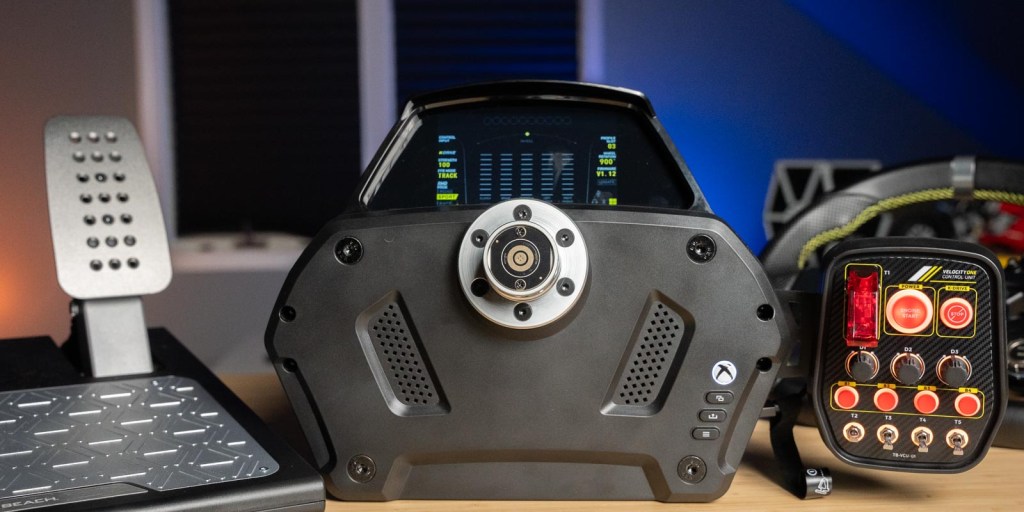
Wheelbase
After knowing a wheelbase is a direct drive, the next spec that everyone looks for is power – how many Newton meters of torque can it deliver to the wheel? VelocityOne Race’s “K-Drive” puts out a peak of 7.2nm of torque – quite a bit more than the popular but non-direct-drive Logitech G923’s 2.3nm and Thrustmaster T300, but there are plenty of more powerful direct-drive wheelbases as well.
Compared to direct drive wheelbases like those from Moza, both less and more powerful, the VelocityOne Race is massive but doesn’t give off premium material vibes. Its plastic construction isn’t as premium-looking as the small, sleek metal boxes that make up most of Moza’s wheelbases.
Mounting the wheelbase is simple. If using it on a desk, there are clamps built into the bottom that can be loosened and tightened with bolts that are hidden under flaps on the left and right of the wheelbase. Another handy feature is the dual hex key that is stored under one of those flaps. I appreciated this design feature as these can be easy to misplace when they don’t have a dedicated spot.
VelocityOne Race: Video
Unfortunately, on my unit, it appears that one of those clamp bolts might be cross-threaded as it doesn’t tighten and loosen smoothly. It still feels solid when I tighten it down but it just takes a lot longer to adjust than it should. The other bolt is smooth and moves easily.
If mounting on a cockpit, which I do think is a much better experience, the three bolt holes are identical to the Logitech Pro wheelbase. It was very easy to get mounted on the PlaySeat Trophy Logitech G edition.
The button box can be mounted on either side of the wheelbase for left or right-hand drive. Around the wheelbase are a ton of USB expansion ports. Currently, the pedals and button box plugin but there are a lot of possibilities here if Turtle Beach decides to expand upon the sim-racing offerings, which they have said they are going to.
On the front are the Xbox, Menu, share, and view buttons. They get hidden behind the whee but can be mapped to the button box.
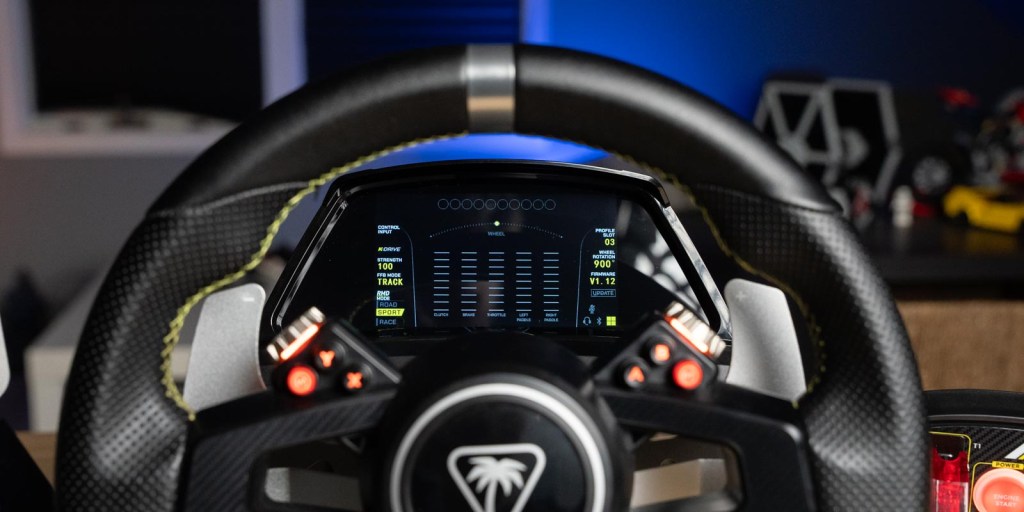
RMD Display
One stand-out feature of VelocityOne Race is the Race Management Display. Other wheelbases like the Logitech Pro Wheel have small displays built in but the Turtle Beach not only acts as a way to control the settings of the wheelbase and pedals but also a digital dash with live telemetry on compatible titles.
While that list of compatible titles doesn’t include any on Xbox at the moment, my contact says that support is coming, and it does work on PC but a third-party app is required.
To get information to show up on the live output dash, I had to download SimHub and install it. Once installed, the software is easy to navigate and get everything set up. I was able to get it working on both Forza Motorsport and Assetto Corsa Competizione.
One benefit of this live readout is that in Forza there is not normally a constant delta of your lap – it only shows up at certain times around the track. With the RMD live dash, though, the delta is always visible which can be helpful.
With RMD, there is also audio control built into the wheelbase. By the power and K-Drive buttons is a 3.5mm port for a headset. In the RMD menu is an area for audio which allows tweaking and even enabling Turtle Beach’s Superhuman Hearing mode which is powerful in FPS games but I’m not sure it’s necessary in racing titles.

VelocityOne Race: Wheel
Like Logitech and the Pro Wheel, Turtle Beach has gone for a removable wheel, but currently, no additional offerings are available.
The VelocityOne Race wheel is the common d-shape with a flat spot at the bottom measuring 300mm wide. Overall the ergonomics feel large on the wheel. The rim is thicker than other wheels that I’ve used and it took me a while to get used to the feel.
Despite that large shape, though, the wheel feels relatively light compared to wheels from Moza and Logitech.
For the most part, the build and materials feel high quality on the wheel, though. The stitched leather material feels higher quality than the ES wheel that comes with the Moza R5.
None of the buttons feel high-quality, though. They’re small and clustered together which can make it hard to find an individual one with my gloves on.
All of the controls you would expect are there. The wheel has two rotating dials, ABXY face buttons, a four-way stick, select and back buttons, and two two-way dials labeled RS1 and RS2 at the top.
On the wheelbase are the Xbox, menu, and share buttons.

Paddle shifters
Behind the wheel are mag-shift paddles which do offer a better experience than the paddles on the stock Moza ES wheel found in the R5 bundle. There is flex in the paddle, though, which makes it feel not as high quality as the Logitech Pro wheel.
In operation, they are quieter than most other magnetic paddle shifters I have tried. For those racing at night, that might be a good thing.
Quick release + connection
The wheel is quick and easy to attach and remove. Here’s to hoping that Turtle Beach expands the wheel offerings with a GT wheel and a round wheel for drifting.
In my unit, there appears to be some slop somewhere in the shaft and the wheelbase. I mainly notice it when large changes in feedback occur like crashes or going over curbs but there is a loud rattle. At first, I thought maybe I hadn’t tightened down the wheelbase completely, but even after checking that the bolts were secure on my cockpit, the loud noise was present.
While it doesn’t necessarily affect my racing, it’s still jarring and distracting. I didn’t want a $650 direct-drive wheel to make these noises straight out of the box. I even found myself muting my microphone when playing with friends over voice chat because I didn’t want the noise to come through.
This might be an intermittent quality control issue, though, as other well-respected reviewers like Boosted Media have not reported this issue.
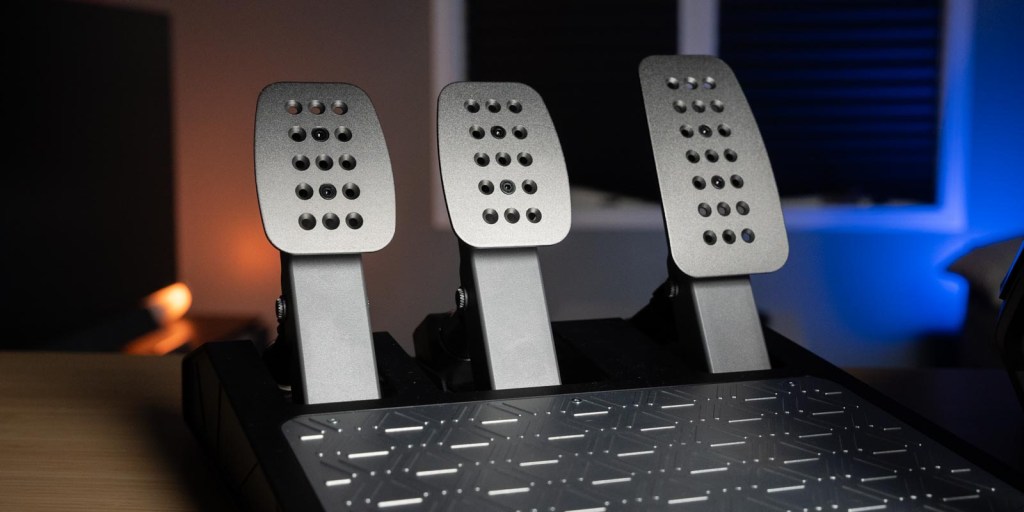
VelocityOne Race: Pedals
Just as important as a wheelbase, if not more, are the pedals in a sim rig. Being able to consistently hit a braking threshold and trail brake through a corner is where most drivers will find the most time gained on a lap in sim racing titles.
Turtle Beach has fitted a load cell brake pedal which is typically regarded as a huge upgrade over a standard hall effect sensor with springs for the brake pedal like you would find in the Logitech G923 or Moza R5 bundle.
Load cell brake pedals measure how much force is being applied rather than the distance the pedal moves.
The VelocityOne Race brake pedal can detect up to 50kg/f of force which is impressive for a pedal setup that can be placed on carpet as well as mounted on a rig.
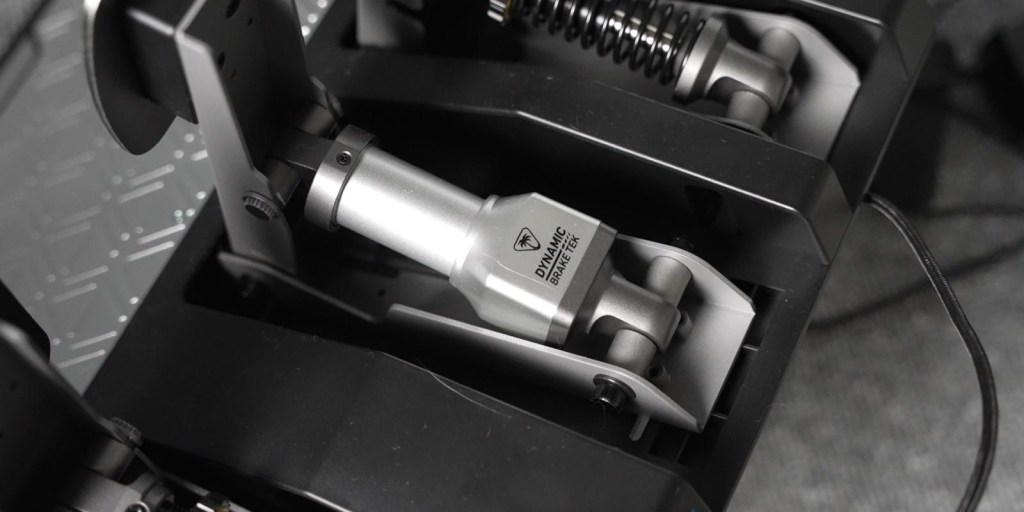
VelocityOne Race also comes with three pedals which is more than some other budget offerings like the Moza R5 bundle. The clutch pedal can be folded down and stored out of the way and the brake pedal can be adjusted side-to-side to dial in the ergonomics. The pedal plates can be moved around as well.
The clutch and throttle pedals have springs that can be tightened for more pre-load which makes them feel stiffer. These adjustments are great to have on pedals.
Setting up the VelocityOne Race pedals is also very straightforward. It comes with sticky rubber pads that can be mounted to the bottom of the pedals if it is being used on a floor. One set has rubber feet to dig into the carpet while the other is flat and meant for vinyl or hardwood floors.
If mounting on a rig, the mounting layout is once again identical to the Logitech Pro Wheel which made it a breeze to mount on my PlaySeat Trophy.
Mounted on a rig, there is noticeable flex in the entire pedal unit when pressing the brake pedal. While I didn’t notice it affecting my gameplay, it is a little concerning to see that much flex in the whole thing.
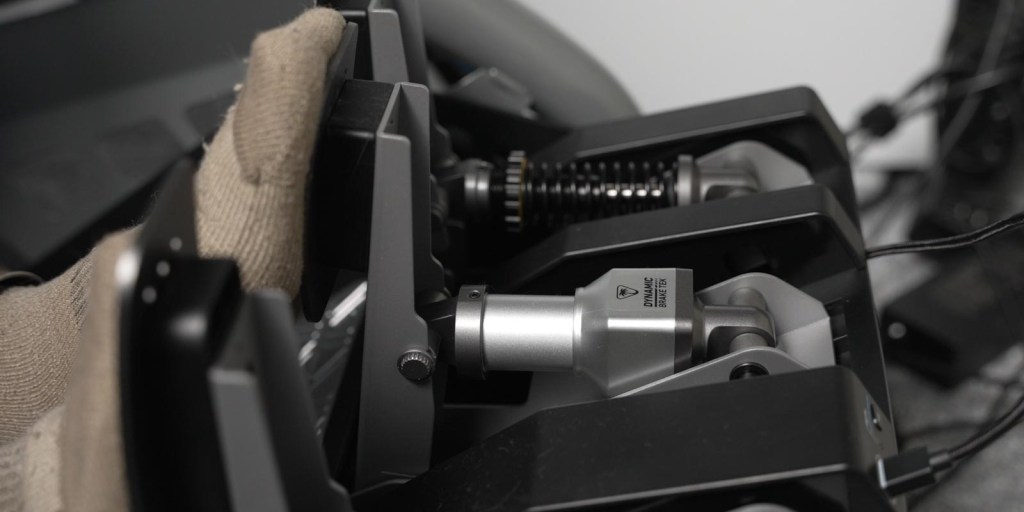
Movement on the brake pedal is shorter than I’m used to with the Logitech Pro Pedals and even the Moza SRP-Lite pedals with the Performance Kit for R5 Bundle. It took some getting used to but when I did I had no trouble braking without ABS in Forza Motorsport as I usually do with other sim rig systems. So while it may not be my preferred overall travel, it worked very well and was effective for finding a braking threshold and modifying my input around that applied force.
Some tweaks can be made to how the brake pedal performs but they’re pretty limited. There are dead zone adjustments and three sensitivity settings.
From what I can tell, these sensitivity settings don’t change how much pressure needs to be applied but rather change the curve of the brake pedal actuation. Low sensitivity turns the pedal into an on/off switch which, for braking, is not what you want. High sensitivity seems to be the most linear setting and is what I found to be the most useful in my testing.
I would love to have the ability to see the maximum pressure required to reach 100% with the VelocityOne Race load cell brake pedal. That is an option on the Moza pedals (even the SRP-Lite) and the Logitech Pro Pedals.
My main reason for wanting to adjust or calibrate the maximum pressure is that I found the pedals to move around on the carpet and I had a hard time finding consistency with braking when it wasn’t mounted on a sim rig. That is going to vary based on the type of flooring from room to room but for me, I had issues on my carpet.
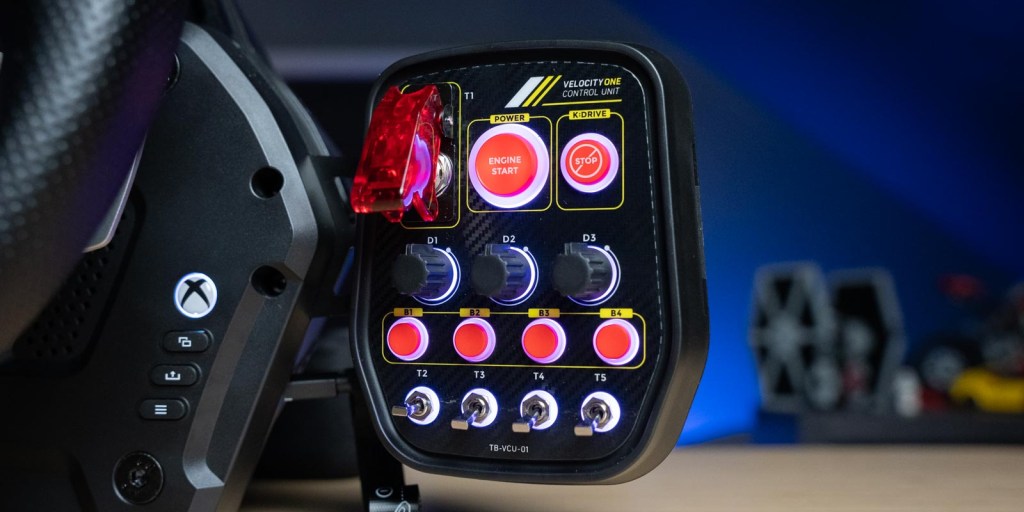
Button Box
Button boxes aren’t new to sim racing but they are often add-ons. It’s pretty rare to see this functionality out of the box and while it might look cool, in practice, on the VelocityOne Race, it almost comes away as more of a gimmick.
Mounting the button box is easy but it is not confidence-inspiring. There is a lot of flex in the mounting bracket which means the whole thing moves when any buttons, dials, or switches are used.
Talking about those switches along the bottom, they are three-way with an up, middle, and down position, but they only send a signal when flipped into the top position. You can easily see this because the RMD screen flashes any button being activated in the top left of the display.
Another gripe of mine is that the start and off buttons at the top control the power of the entire wheelbase and they are very easy to press. A simple miss-press can turn the entire wheel off mid-game and cause some major issues.
On Xbox these buttons and switches can only be mapped to controller buttons and on PC, it appears to be the same. If this box had universal mapping for other system controls, it would make the whole thing much more useful.

VelocityOne Race: In-Use
With everything set up and in use, VelocityOne Race works well on both Xbox and PC. It’s plug and play with both systems and the RMD screen makes it easy to change any settings on the whole setup.
I found myself spending more time on PC because I was experiencing input lag through my Xbox and TV that I don’t have when playing on PC. I also experienced this on the Logitech Pro wheel though so it is just the nature of playing an Xbox on TV – not the VelocityOne Race.
The loud nature of the wheelbase is the biggest downside of this system for me. It was loud enough that I was muting my microphone while on voice chat with friends. It was at least as loud as the G923 which is saying something from a direct drive wheel. With all other DD wheels I’ve tried, they’ve been near silent in operation.
FFB
7.2nm of torque feels substantial in most racing games – there is a lot of potential here. Additionally, in terms of feedback detail at lower speeds, VelocityOne Race is an upgrade over other entry-level wheel and pedal setups like the G923 and T300RS but the feedback did have some issues. I found it to be a bit slower and muddy at the top end than the Moza wheelbases I have been using.
That may be due to a lack of controls for how to customize the feedback. In the menu settings, we have options to tweak strength, center spring, and damping, but that’s it. On Xbox it’s great to have those settings built into the screen but even the entry-level Moza DD wheelbases have much more customizability for FFB and can be tweaked with a mobile device. The VelocityOne Race has a mobile app as well, but it is also simple to make adjustments right on the wheelbase.

Forza Motorsport
In situations where I had to let go of the wheel while playing Forza Motorsport, I would get wheel oscillation, which I also get with even higher-end Moza wheels, but the back-and-forth movement was much slower which was surprising – it acted more like a non-DD wheelbase. It seems like the overall speed of the wheel is less than I was expecting. Maybe that can be adjusted with firmware updates but in its current state, it was disappointing.
Additionally in Forza Motorsport, on longer high-speed turns it felt like the wheel lost all feeling – like it was just maxed out, and moving the wheel in or out wouldn’t change the force in the wheel at all. It felt pretty numb at those extremes.
ACC
A similar thing was happening in ACC. At lower speeds there was plenty of detail and feedback but as soon as the wheel reached the higher end of the force that it can produce, it just became flat without any detail.
In my playback I can see that the game was hitting the peak of what it can put out, there is a force feedback visual in the bottom right of the screen, but even then it was hitting it for a short time and falling off. The wheel didn’t reflect that change in detail on the track.
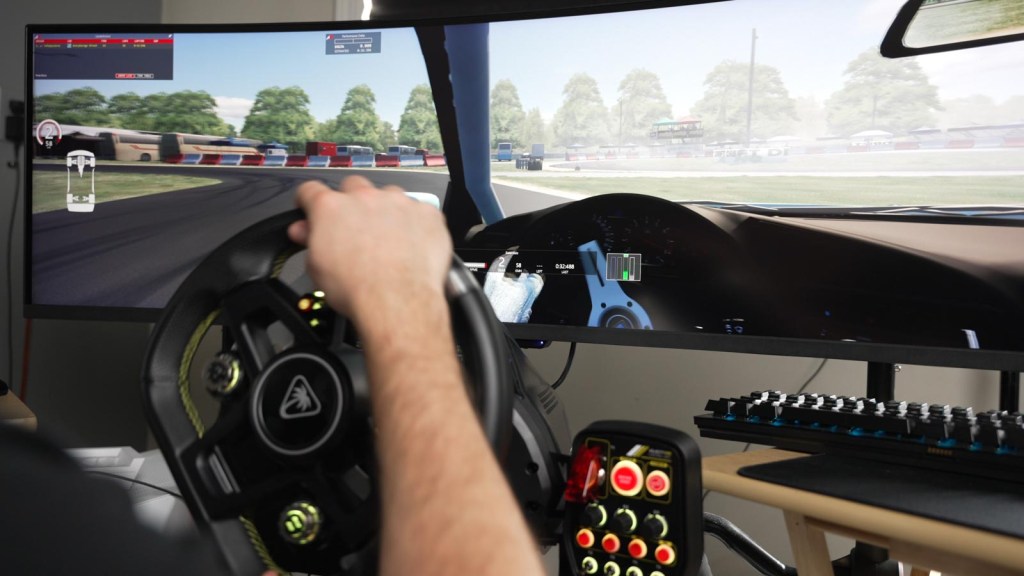
Drifting
I also tried drifting in Assetto Corsa and it worked well. I turned down the strength, turned up the damping, and found a spot that I liked for this wheel. But once again the loud rattling sound made it unenjoyable in my experience and the d-shape wheel isn’t the most ideal, either.
9to5Toys’ Take
VelocityOne Race’s biggest selling point is that is an all-in-one package that is going to be easy to find and purchase in-store. Outside of the sim-racing world Turtle Beach is more well-known than Moza, Fanatec, or even Thrustmaster and might attract new racers because of it.
It’s great to see Turtle Beach entering the sim racing market and going big but some big adjustments need to be made. Many of those can be made with software like adding more FFB adjustments and brake pedal adjustments, but there may be other underlying quality control issues that are harder to catch and fix like the cross-threaded bolt and wheel stem rattle.
I’m excited to see more from Turtle Beach, though, and hope they take this product, learn from it, and come out with more down the line. I think they could strip this down significantly and make a big splash at an entry-level price point.
If I were buying something around this price point, it would not be the VelocityOne Race. I would look at the Moza R5 (currently lacks Xbox compatibility) or one of the Fanatec CSL DD Ready2Race bundles with an Xbox-compatible wheel. While they might not be available at your local Best Buy like Turtle Beach, they offer better performance for the price and are already in a well-established sim-racing ecosystem with more wheel, pedal, and upgrade options.
Buy Turtle Beach VelocityOne Race
FTC: We use income earning auto affiliate links. More.




Comments